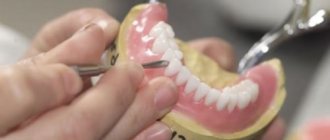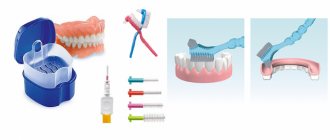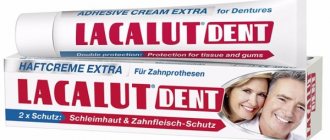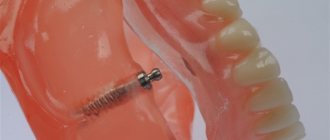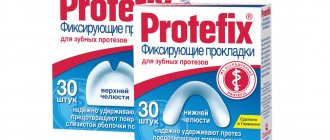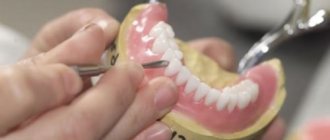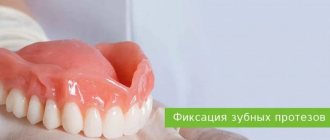May 9, 2021
Anyone may encounter a situation where they require repair of dentures fixed to the dentition. At the same time, it is not at all necessary that the structures will break down only after years of successful operation. According to WHO, about 10% of patients visit dental clinics much earlier - in the first year after installation of products. What is the cause of the problem? What defects are usually found and are all of them correctable? In what cases will devices have to be completely replaced with new ones, and when can they be repaired? This is what today's material from the editors of the UltraSmile.ru portal is about.
The most common causes of failure of orthopedic products
Problems can arise due to overloading of systems, eating too hard food, due to changes in the temperature of the food eaten (cold and hot), due to impacts and injuries, inadequate hygiene care, as well as the use of inappropriate hygiene products (highly abrasive and bleaching pastes, brushes). with hard bristles).
If defects appear after several years of wearing orthopedic devices, this may mean that the materials from which they were made have become unusable. After all, any material has its own permissible service life: for plastic, acetal, silicone, nylon - 2-5 years, for metal-plastic - 3-5 years, for ceramics - 5-7 years, for metal and metal-ceramics - about 7-10 years , for zirconium dioxide and ceramic composite – from 15 years or more.
Is it acceptable to repair damage yourself?
It is not recommended to glue and mask cracks at home, since a non-specialist does not have the necessary tools and materials for this. Using ordinary household and office adhesives to repair a cracked area is fraught with negative health consequences, since the denture is in the oral cavity almost all the time or all day. Possible side effects of doing it yourself:
- the occurrence of an allergic reaction to adhesive components;
- intoxication of the body with harmful chemical compounds;
- development of inflammation in oral tissues;
- deterioration of the condition of the prosthesis due to its damage by unprofessional repairs.
Even if it is possible to connect the edges of a cracked structure with glue, with a “makeshift” approach, at a minimum, the appearance of the prosthesis will suffer. At the very least, you can harm your body or even ruin the structure.
Situation No. 1: there are problems with the appearance and shape of the crown
Nature of defects
As a rule, the integrity of the outer covering of the crowns is compromised. Unsightly chips, small scratches and cracks appear on them. Some patients also complain of the structures changing color from white to yellow.
The photo shows a chipped crown
How the problem is solved
If chips and cracks occur, it is possible to repair the denture directly in the patient’s mouth. The doctor can restore the beauty and integrity of the crown using composite materials and photopolymers. Moreover, this can be easily done both with a broken piece of the crown (then it is glued in place) and without it. As for changing the shade of artificial restorations, this cannot be done by bleaching or other procedures. You can only exchange an old product for a new one if this is a very important issue for the patient.
To prevent the restorations from changing color, immediately after their installation, carefully monitor your oral hygiene, stop smoking and drinking too bright foods and drinks (for example, beets, red wine). Or initially choose crowns from materials that are least amenable to staining, for example, zirconium dioxide. And be sure to do professional hygiene 1-2 times a year.
For such problems, in most cases the crown will not need to be removed. However, if an inflammatory process has developed underneath it (caries, periodontitis, periostitis), then you will have to dismantle the structure to get to the root canals, where the infection usually “sits”, and after treatment, make and install a new one.
What is important to know to prevent breakdowns?
In order for any structure to last for a long time, it is worth thinking about this at the planning stage of its installation. Correctly and accurately installed artificial teeth will correctly distribute the load on the jaw and not overload areas prone to fracture.
In addition, the attending physician at the dental clinic can place a specialized metal structure at the base of the prosthesis. It will be shaped like an arc for the lower denture, and look like a mesh for the upper one. Such seemingly insignificant details will enhance the effect and extend the life of the prosthesis many times over. However, it is worth noting that this will slightly increase the final cost of the structure.
The prosthesis should be stored in a place that is inaccessible to children and pets. An additional recommendation is to avoid being in the sun, as well as near heating devices.
The prosthesis is washed using special solutions that contain surfactants, antiseptics and proteolytic enzymes. They help to easily get rid of food debris and saliva. It is strictly forbidden to use aggressive agents that contain acid, alkali, or abrasives (pumice, tooth powder, etc.). A good tip is to have a separate toothbrush in your home, which is also recommended to be changed every few months.
If your prosthesis breaks frequently, you should consider replacing it with a more modern design. It is better to install an expensive item once than to go to consultations once a year and restore broken elements and chips. Removable dentures made of nylon are less susceptible to breakage than others. Their elastic design easily changes under external load, and then is also easily restored and returns to its original shape without damage.
Problem #2: The bridge is broken
Classic bridges are permanent structures consisting of at least 3 crowns, two of which rest on the teeth remaining in the mouth, and one imitates the missing element. Bridges can also be adhesive and cantilever. These consist of a tooth-replacing crown (or several crowns) and attachments extending from it (clasps, “wings” made of fiberglass and metal tape, special inlays) that are fixed to the “supports.” These orthopedic products fail quite often.
Nature of defects
- exactly the same chips, cracks and shade changes as with conventional crowns,
- breakage, peeling off of fastening elements of adhesive and cantilever bridges,
- mobility of the bridge, formation of gaps between it and the gum,
- fracture at the base of the product.
A gap may form between the bridge and gum
How the problem is solved
In the case of chips and cracks on the crowns of the bridge, repair of dentures is carried out using composite materials. If the fasteners of adhesive structures break, then in some cases it is possible to replace them with new ones, if appropriate. For example, if the replacement crown itself was made of a durable material (ceramics, zirconium dioxide), and not of a composite.
If your composite bridge fasteners break 2 years after the start of its operation, then the material itself must be replaced. That is, in this case it is better to make a new design.
Many patients note that 3-5 years after treatment, the bridges lose stability, begin to wobble, shift, and a gap appears between them and the gum. This spoils the aesthetics of the smile and disrupts functionality. In this case, is it possible to carry out urgent repairs of dentures or their correction to correct the situation?
No, because the cause of the problems in this case is the inevitable atrophy of the bone tissue under the structure, as well as the premature destruction of the supporting teeth, which bear a serious load. And the only way out here is to remove the old devices, carry out additional therapeutic, surgical and periodontal treatment, and then install new devices, which will be made according to the changed clinical situation in the mouth.
If there is a fracture at the base of the bridge, the structure will have to be completely changed.
Repair features
Each case is individual: there is no general repair scheme. It all depends on what material the prosthesis is made from and the type of failure. Let us remind you that there are several types of dentures:
- Acrylic;
- Byugelny;
- Nylon;
- Polyurethane.
For example, breakage of an acrylic prosthesis often occurs, which is explained by the fragility of the material itself. In such a product, the base is mainly broken. If this is a clasp prosthesis, then it has a certain service life after which the product loses its functions. But its repair is not easy. All this is explained by the complexity of the design itself. Depending on the type of defect, different repair methods are used: gluing, sealing parts of the product into one whole.
Problem No. 3: the removable denture has failed
Nature of defects
Removable dentures also have crowns that imitate natural teeth. They are, as a rule, made of lightweight plastic, which wears out quite quickly, chips from excessive stress, and accumulates plaque and dyes. Sometimes artificial crowns fall out of their bed, which is also a problem.
If the structure is only partially removable and is attached to the teeth remaining in the mouth using special hooks and clasps, then it is possible that the fasteners may bend, break or fail.
Another problem is that the prosthesis has become deformed, its shape has changed, the quality of its fit to the gums has changed, and it falls out of the mouth.
Often, cracks and breaks appear right at the base of such products. Naturally, most often due to inadequate load on the structure, overload of its individual areas, or consumption of solid food “beyond their control.” And also when falling from a height onto hard surfaces. Is it possible to repair removable dentures in this case? Here everything depends not only on the nature of the breakdown, but also on the material from which the device is made.
Dentures may break
On a note!
At the stage of adaptation to removable dentures and during their further use, many patients experience discomfort and think that the structures are broken. However, in reality this turns out not to be the case. It’s just that removable appliances have a number of features that you need to be prepared for from the very beginning: they can put pressure and rub the mucous membrane, under load they can stretch and deform, and without frequent corrections and adjustments by an orthopedic dentist, they begin to shift and fall out of the mouth.
How the problem is solved
With denture crowns, everything is simple: chips and cracks are repaired with a composite, fallen artificial teeth are soldered onto a bed designed for them. Doctors are also able to straighten, replace and re-solder hooks for partially removable devices if they are broken. But only on the condition that the supporting teeth are intact and can all also take on increased load. If the “supports” are destroyed, then another prosthesis must be made for a new clinical situation.
What if there is a crack in the base of the structure? This happens quite often, because removable products do not adhere well to the mucous membrane, cannot evenly distribute the chewing load, and over time begin to shift, become deformed and break.
It is most realistic to repair acrylic dentures, as well as models made from soft plastic. To repair cracks and breaks in them and restore integrity, doctors first process the broken edges with special cutters, then carefully align and glue them together, apply plastic to the joints and polymerize them using a special lamp. Then the product is ground and thoroughly polished.
Some dentures can be repaired
But if a break appears in a nylon structure, then orthopedists and technicians, as a rule, will not be able to do anything. If a naturally elastic material does break (this happens rarely; more often it stretches), it can no longer be repaired.
If there is a serious fracture at the base of the product, repairing a removable denture is almost impossible.
If the structures become mobile, shift and fall out of your mouth, then you are unlikely to need repair of removable dentures. In such a situation, it is necessary to visit an orthopedist who will reposition, correct, sharpen and adjust the products to the characteristics of the alveolar ridge, the volume and relief of which changes (decreases) over time. Do not forget that jawbone atrophy occurs under removable appliances.
Cream for fixing dentures “President Garant”
This is an Italian-made product, comes in a standard tube, is easy to apply, fills all gaps and voids, ensuring the tightest possible fit.
Other benefits:
- securely fixes structures for up to 36 hours - an ideal solution for trips, business trips and lengthy events;
- Available in two types: neutral and mint flavor;
- protects soft tissues from chafing;
- the presence of natural plant extracts in the composition;
- compatible with any prosthetic structures;
- no side effects;
- simple and quick installation.
President Garant fixation cream is not destroyed by any food or drink, which ensures guaranteed fixation of the denture
Most popular creams have similar composition and qualities. However, when choosing an adhesive, you should be guided by the dentist's recommendations, this guarantees strong fixation and safe use, taking into account the individual characteristics of the patient.
Where to go for help
It is very important to understand where you can get your dentures repaired. As a rule, the problem should be addressed to the clinic where you had your teeth restored. And it is better to do this urgently in order to prevent larger-scale destruction of the structure and its complete failure, and bacterial plaque getting inside the chips and cracks.
You should definitely consult a doctor
Who should I go to? To an orthopedic dentist. Chips and minor defects can be corrected by the orthopedic dentist himself, but more serious damage (failure of fasteners, fractures in the base of the structure) is dealt with by dental technicians who work in the dental laboratory at the clinic. But, of course, there is usually no need to contact them directly, since all issues are resolved through the attending orthopedic doctor.
It is better to get dentures in clinics (or a network of clinics) with their own dental laboratory. Otherwise, you should not count on urgent repairs of dentures if they break. Typically, laboratories for third-party dentistry take much longer to complete orders than for their own. Thus, repairs can take several weeks or even months.
Linear fracture
In order to repair a denture, a dental technician glues its two parts together with super glue, mixes plaster and makes a plaster model of the denture. After crystallization of the plaster, the prosthesis is removed from the model, again opened into two parts, and a thick layer of plastic is removed from the prosthesis along the fracture line. Using an electric motor and a disc, herringbone cuts are made on the two parts of the prosthesis and they are placed back on the plaster model. Cold polymerization plastic is diluted, after it has matured, it is applied along the fracture line and leveled to the thickness of the prosthesis. The model is placed in cold water for 10-15 minutes to complete polymerization of the plastic. After time, the outer and inner surfaces of the prosthesis are ground using cutters and polished with rubber bands and felt.
Why you can't do repairs at home
Some people are not at all interested in where they can glue a denture in case it breaks or chips. They try to carry out the restoration on their own, at home, and sometimes with office and household adhesives. This is unacceptable, since non-specialized adhesive compositions are unsafe for health and can lead to intoxication of the body and allergic reactions. In addition, they can corrode elements of an artificial structure.
“After installation, my grandfather started rubbing his prosthesis; there was supposedly a sharp edge that dug into his gums. So a neighbor on a bench near his house advised him to cut it himself. The grandfather did not consult with anyone and carried out this plan alone... And then his gums began to hurt terribly and all his gums became inflamed, he could not wear a denture at all and could not chew either. For three months I sat on soups and broths alone. The doctor was horrified when he saw his grandfather's work. He said that we’ll cure the gums, but we’ll have to install a new prosthesis after such an amateur performance...”
M_Dmitry, fragment of a review from the site gidpozubam.ru
At home, it is impossible to properly process the edges of the fault and make them smooth. As a result, the structure will rub and injure the tissues with which it comes into contact. Home repairs can permanently damage your prosthesis, disrupting its aesthetics and functionality. The result of this will be the need to undergo re-prosthetics.
Notice
: Undefined variable: post_id in
/home/c/ch75405/public_html/wp-content/themes/UltraSmile/single-item.php
on line
45 Notice
: Undefined variable: full in
/home/c/ch75405/public_html/wp-content /themes/UltraSmile/single-item.php
on line
46
Rate this article:
( 2 ratings, average: 5.00 out of 5)
prosthetics
- Afanasyeva V.V., Lebedenko I.Yu., Grachev D.I., Arutyunov S.D. Increasing the efficiency of restoration of removable plate dentures after breakage // Russian Dental Journal. – 2014.
Expert “The reasons for the breakdown of prostheses are not always related to the patient’s mistakes made during use. Devices can fail early if they were initially poorly manufactured and installed incorrectly. Or in cases where the supporting teeth began to decay or become loose, the gums became inflamed, and bone tissue atrophied. And in such situations, what is needed is not repair of dentures, but their correction or even complete replacement according to the new clinical situation. As well as treatment from other specialists, for example, from a dental therapist.” Orthopedic dentist Sambuev Bair Sergeevich
Consulting specialist
Sambuev Bair Sergeevich
Specialization: Orthopedic dentist Experience: 11 years
Why is it undesirable to do structural repairs at home?
If, after the prosthesis broke, the patient turned to a specialist, then the repair may take only one to two hours. In this case, only safe materials will be used for restoration.
Self-recovery will not only take more time, but will also create the risk of permanent failure of the structure. In addition, if conventional adhesives such as “Moment” are used for repair, this can lead to poisoning of the body or cause a severe allergic reaction.
Comments
What if my prosthesis breaks six months after the prosthesis? Who will pay me for the pleasure of repairing or replacing it? Isn't it the clinic itself?
Maria Ivanovna (05/27/2021 at 00:35) Reply to comment
- Dear Maria Ivanovna, if the case is within the scope of the warranty and service provided in the contract with the clinic, then, yes, the repair or replacement of the prosthesis will be carried out at the expense of dentistry. Typically, orthopedic products are provided with a warranty for a period of 1 to 3-5 years (each clinic individually, not to be confused with the service life of prostheses!). If during this period the prosthesis breaks due to the fault of the clinic specialists, for example, it was poorly manufactured and installed, then the patient can count on free repairs and replacement. At the same time, it is very important that the patient observes all the conditions under which the warranty obligations will be fulfilled, and does not try to repair the prosthesis on his own or in a third-party organization. Otherwise, the clinic has the right to refuse to provide free services.
Reply from the author of the article (05/30/2021 at 09:18) Reply to comment
Hello. Tell me what can cause a removable denture to become deformed (not crack) and how long does it take to restore such a denture? And what kind of food is considered super hard to avoid damage.
Olga Ivanovna (07/08/2021 at 08:22) Reply to comment
What to do if the denture rubs the gums? About a month of using the prosthesis passed and it began to rub the gums and, accordingly, it became painful to bite.
Olga (07/08/2021 at 09:50) Reply to comment
Hello. I had prosthetic teeth in one clinic, but after 8 months the prosthesis broke. I went to another clinic to have the prosthesis repaired or a new one made. But the doctor said that a new one was needed, since the prosthesis was made from low-quality materials. The previous clinic said that they were made of metal, but in fact it turned out that they were made of metal-plastic. The clinic where I did it initially is not there. But there was a 1 year warranty. Please tell me how to identify a prosthesis, what it is made of, and what to do in this situation.
Alexey (07/08/2021 at 11:33) Reply to comment
My mother’s dentures are becoming unusable, but she is in no hurry to change them yet, since this is not a cheap procedure, although she feels discomfort. Tell me, is it dangerous for the integrity to delay this or not?
Ekaterina (07/08/2021 at 11:57 am) Reply to comment
I must admit, at first I thought about false plastic dentures. But no, this is about metal ceramics. Tell me, what percentage of patients with crowns turn to orthopedists with a similar problem?
Lesya (07/08/2021 at 12:10) Reply to comment
Due to injury, the face has a displacement in the jaw area. Tell me, please, can a prosthesis be made in full accordance with the broken symmetry? And won’t there be discomfort in the future, because there are a lot of movements during the day?
Denis (04.08.2021 at 16:24) Reply to comment
If a metal-ceramic crown begins to change color, does this indicate that it is deteriorating, or is the problem purely aesthetic? Will replacing the product directly harm the tooth?
Sonya (08/04/2021 at 18:19) Reply to comment
Tell me, I have a metal-ceramic crown. Recently, under the crown, I have noticed that the gums have darkened. This indicates that it is time to change the crown, has it become unusable? Perhaps there is an option for cleaning the gums under the crown? Or is it a gum problem?
Maria (08/05/2021 at 12:07 pm) Reply to comment
Write your comment Cancel reply
What about fixed dentures?
A bridge, veneer or crown can also break, chip or crack. In such situations, specialists act based on the amount of “destruction” - from restoration with a composite to complete replacement of the structure. The technical complexity of repairing prostheses of this type lengthens the time required for completion. However, there is no other way out; it is not only uncomfortable and unaesthetic, but can also be dangerous.
In Moscow, eliminating a breakdown is both easier and, at the same time, more difficult. A sea of offers, different prices, but who really deserves trust, because this is health?
Stock
-20%
Manufacturing of removable denture Acry Free 40,000 rub.
32,000 rub.
get -27 %
Teeth in 1 day on Straumann implants using ProArch technology!
300,000 rub. 220,000 rub.
get -17 %
Quadrotti dentures (without palate) 60,000 rub.
50,000 rub.
get -20 %
Manufacturing of removable denture Acry Free 40,000 rub.
32,000 rub. get
How long does an emergency repair take?
The duration of restoration of the orthodontic structure depends on what kind of malfunction occurred. Namely:
- A small crack or chip can be repaired in one to two hours.
- To repair a metal arch or clasp, a dentist will need one to two days.
- It takes five to seven days to make a new denture.
Before using the services of a dental laboratory, you should consult with your dentist. Repair and production of dentures without medical advice increases the risk of another breakdown or complete destruction of the orthodontic installation.
